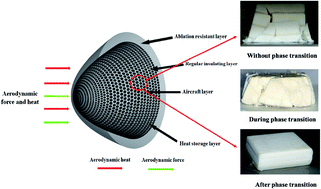Experimental study of the thermal storage and mechanical properties of microencapsulated phase change composites during a supersonic cruise
Abstract
Microencapsulated phase change composites, one of the high-efficiency thermal protection media, are widely used in the thermal protection of supersonic aircraft. The phase transition occurring during the cruise of supersonic aircraft leads to a change in the mechanical properties of microencapsulated phase change composites (MPCMs). In this study, we experimentally studied the variations of the mechanical properties of MPCMs during cruise. The effects of the volume fraction ratio of core to shell on the thermal storage and mechanical properties of the microencapsulated phase change composites are investigated. Results show that the latent heat capacity increases with an increase in the volume fraction ratio of core to shell. The deformation mode translates from a brittle fracture into a brittle deformation status during the phase transition. The mechanical properties of the MPCMs decrease at three conditions without phase transition, during phase transition and complete phase transition, respectively, with an increase in the ratio of core to shell as well as increased temperature. The above-mentioned findings can guide the design of a best thermal management system for supersonic aircraft.



 Please wait while we load your content...
Please wait while we load your content...